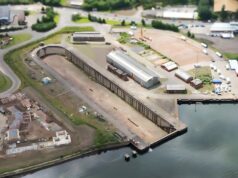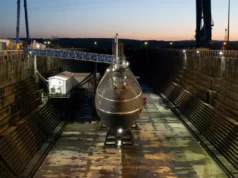The UK’s nuclear deterrent programme has received a further boost through a major US Navy contract modification worth nearly $1 billion, part of which supports the joint Common Missile Compartment shared between Britain’s Dreadnought-class and America’s Columbia-class submarines.
The $986,785,825 modification to an existing contract with General Dynamics Electric Boat includes “previously scheduled United Kingdom (U.K.) funding modification in the amount of $16,035,000… for the continued support of the joint U.S. Columbia-class and U.K. Dreadnought-class common missile compartment program,” according to a Pentagon contract announcement released 20 June.
The shared compartment design is a key element of the next-generation deterrent platforms for both nations, underpinning the Royal Navy’s continuous at-sea deterrence capability through the future Dreadnought-class submarines.
The contract also includes support for wider industrial capacity under the U.S. Navy’s Submarine Industrial Base (SIB) initiative, with the Pentagon noting that “the industrial base development work is for the furtherance of the Navy’s plan of serial production of Columbia-class and Virginia-class submarines.”
The work will be carried out at three US locations: Groton, Connecticut (70%), Newport News, Virginia (15%), and Quonset Point, Rhode Island (15%). Completion is expected by December 2031.
Crucially, the award aligns with the findings of the fiscal year 2025 Submarine Industrial Base Study (SIB25), which sought to enable what the Department of Defense calls “the once-in-a-generation recapitalization of the submarine force.” The contract confirms that “SIB projects in this contract modification directly support the direction of OMB, OSD CAPE, and the Navy.”
Funding includes over $794 million from the US National Sea-Based Deterrence Fund, alongside the UK’s $16 million contribution. The remainder is made up of other US Navy budget lines.
The Common Missile Compartment is a central feature of both Columbia- and Dreadnought-class submarines, enabling the deployment of Trident D5 ballistic missiles and maintaining full compatibility between UK and US launch systems. UK construction of the Dreadnought-class is underway at BAE Systems’ Barrow shipyard, with first-of-class HMS Dreadnought due to enter service in the early 2030s.
At the UK Defence Journal, we aim to deliver accurate and timely news on defence matters. We rely on the support of readers like you to maintain our independence and high-quality journalism. Please consider making a one-off donation to help us continue our work. Click here to donate. Thank you for your support!














Brilliant news, at least the UK doesn’t have to cough up any of that $1,000,000.
UKPLC doing the business.
Hang about, Trump has just heard about it. He now wants 1 billion beautiful dollars or it’s goodbye UK. 🤣
As the resident idiot in the room, could the missile compartments be used to launch weapons such as Tomahawks?
Should it be so, would this make a great insertion into our future SSN fleet?
In theory you could modify them to launch TLAMs akin to what the USN did with 4 of its Ohio SSBNs converting them into SSGNs, but it would be horrifically expensive and far too big to be carried on an SSN. The SSN-AUKUS boats will likely have either a Virginia Payload Module with 40 missiles inserted into them or a dozen VLS tubes like the earlier Virginia boats have.
Thank you Ben.
I think the working plan is for SSNr /Aukus to have the Virginia class payload module- having the ability to fire up to 40 standoff land and surface attack missiles is a very attractive capability.
The problem is that there aren’t very many situations where an SSBN is in a position to launch tactical weapons.
For example, to make them useful in the Middle East would require a transit all of the way round to the Indian Ocean, for some of which North Korea and maybe even Moscow would be out of range of Trident. Then the launch would indicate the position of the sub, further compromising the deterrent.
It is a niche day one capability.
Fire a massive and overwhelming salvo from a position that might be harder to defend from.
As you say it has myriad drawbacks including being stationary while the missile stock is depleted….
Yes you could put TLAM in the CMC but as we have reduced the numbers of tubes / Missiles from 16 to just 12 you would be sacrificing 1/12th of the UKCASD for each CMC repurposed.
Whats probably more serious is you need to get closer to the target as it has considerably less range and then you give your position away, which sort of completely destroys the theory of how CASD works.
Our SSNs carry TLAM at present which we launch via the Torpedo tubes, but the US is now focusing on VLS launch and development of future torpedo launched TLAM version has been discontinued.
Which is why the next generation of SSN(A) will have TLAM VLS just like the Virginias.
So to sum up using a TLAM in a CNC is possible but a very dum idea (which pretty well guarantees the Treasury led MOD will probably do it as a cost saving on buying more SSN(A) 😂).
Hi Rodders
Couple of people have mis-read what I wrote.
I was asking if we could put the CMC into the future SSNs as a way of delivering Tomahawk capability from our future SSNs.
The reason I was asked was that it would increase the orders for the system and therefore spread the cost over 12(?) SSN and 4 SSBN.
It would also deliver more capacity with SSN tubes freed up for torps.
Thanks for answering.
I believe the USA developed a different system replacing one tube for ballistic missiles with seven tubes for cruise missiles, so it wasn’t the same tube and wouldn’t produce any cost savings.
But did you say thank you??